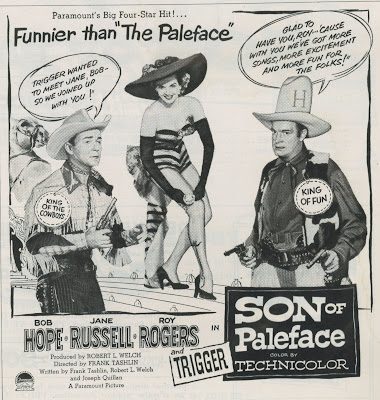
Son Of Paleface and What's Funny --- Part One
I'm starting to question the whole Laughter is Contagious thing, having been told since forever how comedies play so much better in a crowd. Does an audience magically transform a show that isn't funny into one that is? Sitting alone with clowns is frightful prospect for many, but is that because they need others to cue them when to laugh? Is it a herd mentality that makes us seek out capacity rooms and reassurance that what we find amusing is indeed that? Ann sometimes wonders why I don't laugh (audibly) at comedy we agree works, and I respond that everyone's mirth mechanism differs. It's possible to appreciate humor more even if you laugh at it less. I once rolled off the sofa before an Ace Ventura routine most cultivated watchers would deplore, and I'd not call Jim Carrey an equal to comics of the GPS pantheon, so is there disconnect between my "appreciation" of comedy and response the basest of it sometimes provokes? Too often I find myself clocking laughs others might get from stuff I've watched too many times, Son Of Paleface most recent object of said cold analysis. There's sadness in time spent alone with movies crafted to please hundreds per unspooling, but we'll not see SOP through 1952 eyes again. A lot of us never did. Look at all this publicity and tieing-in, then imagine mobs primed to show up and guffaw at everything this cast laid down and called hilarious. I feel for ones who saw Son Of Paleface in that white-hot '52 summer, only to re-encounter it later and wonder why it didn't seem so yok-some anymore.

So this is maybe the best Bob Hope he did sans Bing. What does that say about the others? Serious notice of SOP came as result of Frank Tashlin directing, though I'd cringe at prospect of this one screened in a university classroom, straight-back chairs and an instructor to drain whatever amusement might inadvertently have come his pupils' way. I'll close Tashlin's part by acknowledging best gags as impossible ones he staged like cartoons done at career beginning with WB. Such came natural to a Bob Hope long versed in crashing fourth walls and well along conspiring with viewers to undermine pic conventions. We like Bob best when he's most irreverent. Here he was pushing (at least) fifty, displaying cheek of a newcomer half that age. Think longevity of this man's career and name another who approached it. Son Of Paleface plods here/there, I'd question how some thudding gags clicked even for packed houses, but when this one delivers, it's transporting, best moments being comedy sure-footed as was possible in days when likes of Hope defined what made a culture laugh.

He was an all-media titan then, as witness deal lately wangled with anxious Paramount. Bob had wanted more, always more, to stay on contract board ... fifty, maybe sixty, percent of receipts. Guess Para knew he could get it elsewhere, as they pret-near handed Hope keys to the Marathon gate and coffers within. Not unlike the Hal Wallis deal worked out previously, this was setting for Hope to have a studio address for making features he'd bankroll, then own outright. The Lemon Drop Kid ... was produced by Hope Enterprises with its own coin and without financial help from any bank, observed Variety when news of the renewed pact came down in September 1950. Hope was that early planning a spoof western with Roy Rogers, to be ankled by Lemon Drop profits. How did Paramount prosper in all this? They'd have the star for eight total commitments, four via Hope Enterprises and the balance in-house for which he'd get salary plus percentage (estimated by Variety to be about 25%). Budgets for each would be $1.5 million, in line with increased studio scrutiny over bottom-lines. In addition to total control of his own productions, Hope approved writers, directors, and players utilized for the Paramount shows. Added Variety: Complications between motion pictures and television will be straightened out by another clause which calls for a timing arrangement. It provides that Hope, the TV star, will not make live video appearances in spots where Hope, the Paramount star, is on the screen in first-run theatres. In this way, he won't be competing with himself.

Whatever its share of eventual profits from Son Of Paleface, Paramount could at least boost distribution fees by making theatres bid for what everyone knew would be a sure-fire hit. There were complaints in July 1952 of Para's failure to tradeshow Son Of Paleface, as if anyone needed proof it would score. Drive-ins had begun competing for new films and getting them. Los Angeles ozoners grabbed SOP and Paramount's other summer laff- getter Jumping Jacks for same day open as indoor houses, having ponied a $5,000 guarantee plus $1,000 more to defray distribution's advertising costs. A new era of cutthroat bidding was upon showmen across the land, perceived best product hotly chased for bragging rights as much as profit gained. With theatres now divorced from former owning producer/distributors, it was every exhib for himself. Paramount demanded advances to $27,500 plus a four-week minimum run for Son Of Paleface in Philadelphia. The Fox Theatre there smiled and paid up. With 2423 seats and overhead like theirs, what were options? Such a palace couldn't afford booking product less than a cinch for full attendance.



